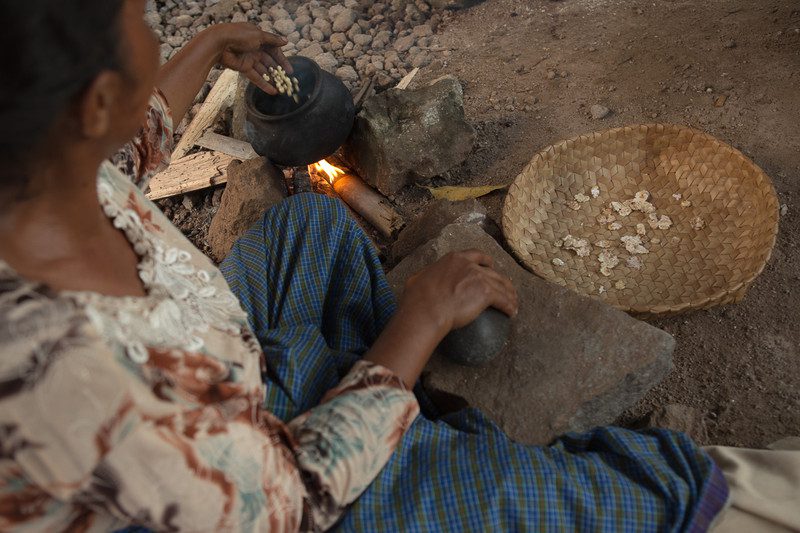
One in eight people go hungry every day. Unbelievably, 80% of those going hungry are food producers; small-scale farmers, fishermen and women, forest foragers and landless farm labourers. They produce food, yet many still go hungry.
The road to Hoelea from Lewoleba on the island of Lembata is the worst I’ve ever seen. It takes around 10 hours to cover the approximately 80-kilometre round trip. Much of the bitumen has been washed away and what’s left sometimes forms islands in the middle of this single lane road with a drop of a foot or more the ground beside it. This makes for a lot of weaving backwards and forwards for all forms of transport, including those wishing to get their produce to market.
As we crawl along, we pass crops of sorghum, corn, and plantations of coconut and banana — the former growing wild right up to the roadside. We pass women carrying what look like heavy loads on their heads, often food, while other women sell drinks and snacks including fish at roadside kiosks.
When we finally arrive in Hoelea we quickly set-up to record a meeting of seven women representing various groups from nearby villages who have gathered to tell their story and discuss their plans for reducing hunger in their respective communities. Local food security activist – and our guide – Siti Rofi’ah, updates the group on her recent trip to Jakarta where she spoke with government officials and the media about hunger on Lembata. Then we hear from each woman in turn.
Ibu Susana Kewa (aged 54) lives in the neighbouring sub-village of Hoelea 2. She grows tomatoes, peanuts, sawi (mustard leaf) and eggplant. She tells the group about her continuing struggle to access water, “There is a problem with the water,” she says. “It is a long way away. It is hard for us older women … we need a machine to dig and pump it up [and] channel it [to our crops].”
Ibu Yohana (aged 27) lives in Hoelea Satu. She grows sweet potato and bananas. She tells the room that she has problems “marketing” her crops. She produces crackers from her crop — similar in shape and texture to the prawn crackers that are widely available in Australia — before selling them at a nearby kiosk. But they are difficult to sell she explains, before explaining her need for tools to prepare and package the crackers.
As I work my way around the group, inviting members to speak, the women grow bolder. Their stories come more quickly and with less anxiety at the video camera that swings to each of them in turn.
Afterwards, Ibu Maria Peuma (aged 45) gives a demonstration in the making of Jagung Titi — essentially corn flakes without the sugar and artificial colouring (and so a lot more real looking). While the kids crowd around to get some of this hand-flattened corn — the kernels individually pummeled by Ibu Maria with a large river stone — I’m approached by Ibu Teresia Boleng (aged 49), one of the women I spoke too while filming earlier. She asks me, “What are you going to do with these words?” She asks with an intensity that demands, “I don’t want any lip-service from you, son!”
Watch a longer video about food security activist, Siti Rofi’ah.
By Juan Martorana who visited Indonesia earlier this year.
Write to the Australian Government urging it to play a leadership role in tackling global hunger. Find out more and take action.
